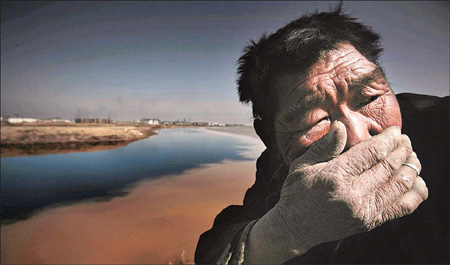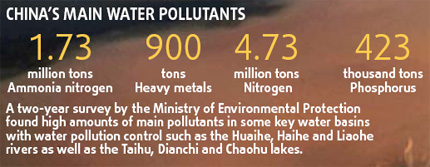Pollution 'likely to peak at earlier stage of growth'
 |
|
A local herdsman faces a polluted river in a village near Shizuishan city in the Ningxia Hui autonomous region. [Lu Guang/China Daily] |
The country might see its pollution levels peak at an earlier stage of economic growth than expected, a senior environmental official said on Tuesday.
"China has taken a different growth path from developed countries so it is very likely that our pollution peak will come earlier," Zhang Lijun, vice-environmental minister, told a news conference in Beijing during a release of the first national pollution census.
The peak could occur when the country's per capita income reaches $3,000, Zhang said.
China's per capita gross national income hit $2,770 in 2008, a report from National Bureau of Statistics (NBS) showed.
Wang Yuqing, director of the national leading office for the pollution census, said the country's emissions of major air and water pollutants, sulfur dioxide and chemical oxygen demand (COD) - used to determine the amount of organic pollutants found in water - have already reached peak levels and started to come down, as a result of its stringent pollution reduction targets during the 11th Five-Year Plan period (2006-2010).
The national pollution census, which mapped more than 5.9 million sources of industrial, residential and agricultural waste throughout the country, showed that China discharged about 209 billion tons of wastewater and 63.7 trillion cu m of waste gases in 2007.
Most of the industrial pollution come from a small number of industries and are mainly concentrated in economically well-off areas, Zhang cited the census as saying.
For instance, 81.1 percent of industrial emissions of COD come from seven industries such as paper-making, textile, agricultural processing and chemicals, according to the census.
Similarly, six industries including power generation, heating, minerals and non-ferrous metal smelting account for 88.5 percent of total sulfur dioxide emissions.
A database for the census has been established to cover environment-related information nationwide, which can provide a basis for administration and policymaking, Zhang said.
Wang told China Daily the public will likely gain access to the database by the end of this year, while detailed pollution information for different industries will also be published in the future.
"Results from the pollution census largely conformed with our understanding about the country's environmental issues, such as the distribution of pollution sources," Zhang said.
The only difference between the census and previous environmental statistics comes from the amount of COD emissions, Zhang said.
 |
|
[China Daily] |
While the NBS reported 13.8 million tons of COD emissions in 2007, the census showed that a total of 30.3 million tons of COD was discharged that year.
Zhang said the difference could be explained by the survey's expanded scope, adding in agricultural sources of wastewater, which contributed about 13.2 million metric tons, as well as residential sewage.
This also showed that agricultural pollution has a notable influence on the country's water environment, which means the prevention and control of agricultural wastes must be strengthened, Zhang said.
Wang Yanliang, a senior official from the Ministry of Agriculture, said livestock farming as well as the excessive use of fertilizer and pesticides are the major contributors to agricultural pollution.
"The government will continue to promote the construction of household biogas projects to deal with manure and animal waste," Wang said.
Greenpeace Campaign Director Sze Pang Cheung said the census has far-reaching implications for China's efforts to curb emissions.
"The Chinese government should use the statistics as the benchmark to prioritize the country's biggest pollution issues, review current measures and policies, and set up more stringent pollution control targets in the 12th Five-Year Plan," he said.
 0
0 






